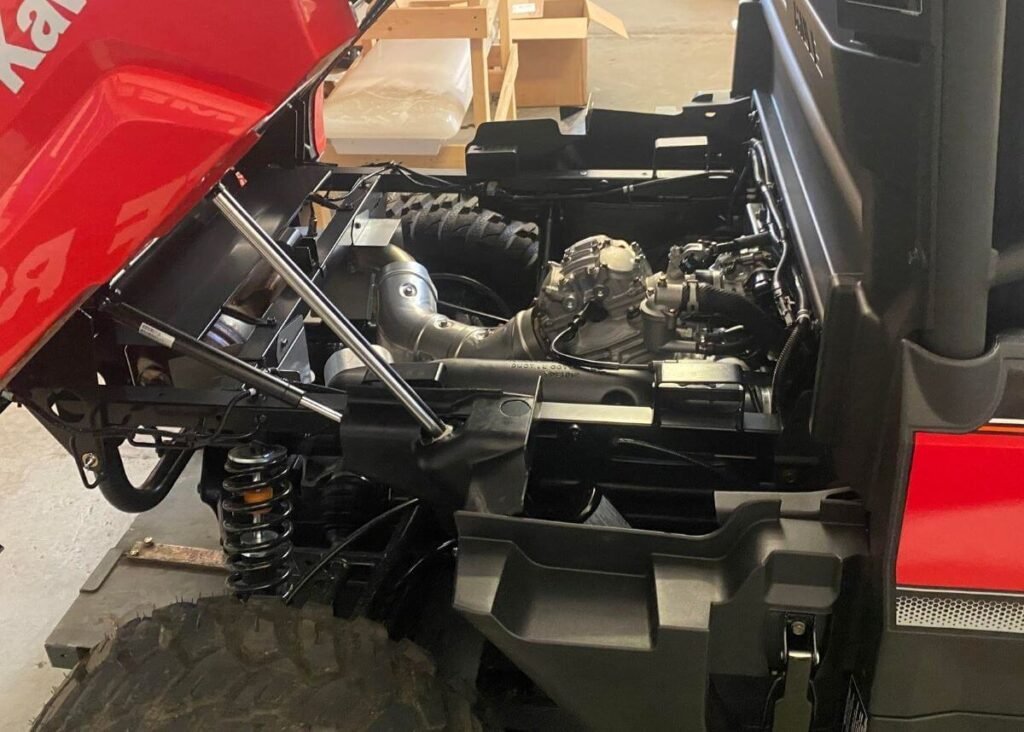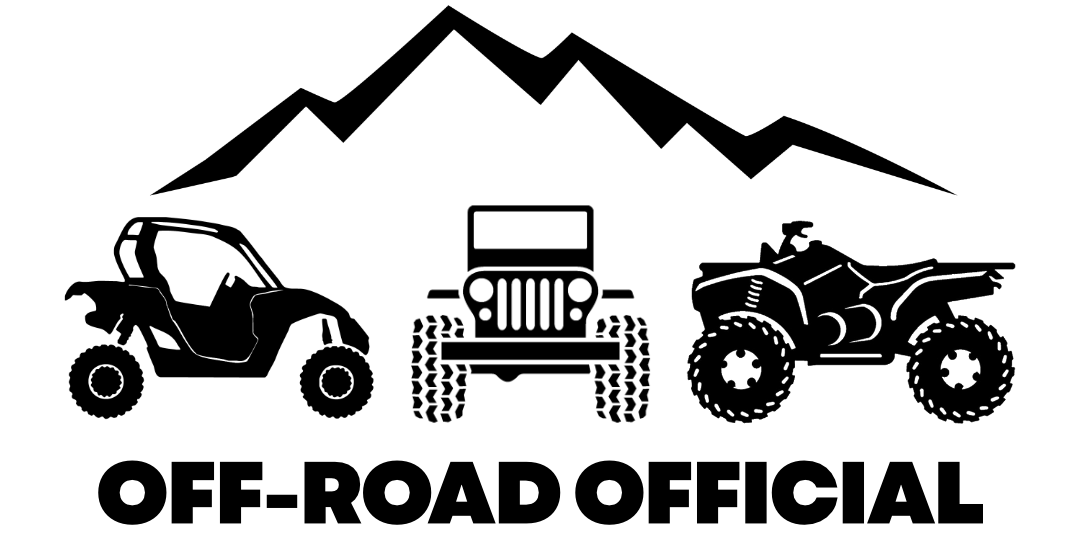One look at the Kawasaki Mule Pro MX, and you may not be overly impressed.
Though it boasts a modern, ruggedly-appealing look, it’s not as eye-catching as some of its counterparts on the UTV scene.
Lucky for you, having a look through the list of eleven most popular Kawasaki Mule accessories will help change that.
And as one of the more compact mid-size utility vehicles around, it doesn’t wow you with its build like some of the bulkier units out there.
But don’t be fooled, the Mule Pro MX is a straight workhorse just like the ever-popular Mule 4010, and it will absolutely impress you in the ways a true utility vehicle is intended to.
What it may lack in style, it makes up for in comfort, reliability, and durability. This guide will include a detailed review of the specs, features, and pros and cons of the Kawasaki Mule Pro MX.
About The Kawasaki Mule Pro MX
For those familiar with the Kawasaki Mule 610 through its discontinuation in 2016, the Mule Pro MX came along in 2019 as its replacement, being essentially the same model but with fuel injection and some modern touch.
Slightly bigger than the Mule SX and smaller than the Mule Pro FX, the Mule Pro MX is offered as Kawasaki’s mid-size utility vehicle.
As a two-seater with a roomy cab and large cargo bed in back, its main functionality is work – which it excels at.
And with heavy duty construction both internally and externally, it is built to last.
The Mule Pro MX is offered in five different models, with the most popular being the Mule Pro MX EPS models – which make up four of the five and will be the focus of this guide.
The specs of all five models are mostly identical with the main differences being included accessories, which will be compared further along in this guide.
Mule Pro MX EPS Specs & Features
Engine
With plenty of power from its 695 cc, single-cylinder engine, there aren’t many tasks or terrains the Mule Pro MX EPS can’t tackle.
Rocky, muddy, or mountainous – it doesn’t matter, this Mule will power you through.
And its ample low-end torque helps make it capable of maintaining consistent momentum and traction in rough terrain, which is important with a heavy load in tow.
Vibration-reducing mounts and an intake silencer ensure the engine runs quiet and smooth without much vibration in any gear, including idle.
Although the engine is not quite as powerful or steady as the 812 cc engine in the larger Pro FX Mules, it’s not far off.
The engine features a rugged construction with a sturdy frame encircling it. And the simple setup is a big plus when it comes to maintenance.
Changing the oil, spark plug, filters and anything else engine related can be done easily with a raise of the cargo bed or lift of the seating.
| Engine Type | Four-Stroke SOHC, gas |
| Cylinder Arrangement | Single Cylinder |
| Displacement | 695 cc |
| Maximum Torque | 42.7 lb-ft @ 5000 rpm |
| Horsepower | 33 hp |
| Bore x Stroke Ratio | 102.0 x 85.0 mm |
| Compression Ratio | 10.3:1 |
| Carburetion System | Direct Fuel Injected (DFI) |
| Engine Cooling | Liquid Cooling |
| Fuel Capacity | 9.5 Gallons |
| Ignition System | Battery and coil |
| Battery | 12V 35Ah |
| Spark Plug | NGK CR7E |
| Lubrication System | Forced lubrication (wet sump) |
| Engine Oil Type | API SG, SH, SJ, SL or SM with JASO MA, MA1 or MA2 |
| Engine Oil Viscosity | SAE 10W-40 |
| Engine Oil Capacity | 4.5 L (2.5 US qt.) |

Drivetrain
The Mule Pro MX EPS makes use of a fully automatic, belt-type CVT transmission.
A centrifugal sprag clutch helps to protect the belt while providing smooth clutch engagement and engine braking in four wheel drive.
Drive shafts provide power to the front and rear differentials.
Without a park setting in the transmission, it is necessary to engage the T-Handle parking brake mounted on the dash when stopped.
Otherwise, the Mule can roll as it is essentially in neutral when not in gear.
The lack of a park setting is becoming common in modern UTVs as a parking brake puts no added wear on the transmission like a park setting will.
This Mule offers selectable two-wheel and four-wheel drive via a button on the dash.
It also offers dual-locking rear differential, meaning you can unlock the rear differential to put the Mule in “turf mode”.
With the rear differential unlocked, only one wheel provides power when turning which prevents the Mule from tearing up grass and other soft surfaces or leaving skid marks on the driveway.
It also enables tighter turning.
| Drive System | 2WD/4WD w/ Drive Shafts, Belt Drive Torque Converter (CVT) |
| Transmission Type | 2-Speed and Reverse, Automatic |
| Gear Shift Pattern | L-H-N-R |
| Primary Ratio | 2.451 ~ 0.791 |
| Final Reduction Ratio | Front – 4.375, Rear – 4.375 |
| Overall Drive Ratio | Forward – 37.384 ~ 12.065 (High), 71.266 ~ 22.999 (Low)Reverse – 56.947 ~ 18.378 |
| Transmission Gear Ratio | Forward – 3.486 (High), 6.646 (Low)Reverse – 5.311 |
Tires and Brakes
The Mule Pro MX EPS comes fitted with 25-inch Duro tires, which are pretty aggressive for a standard utility vehicle.
These tires are constructed of heavy duty 6-ply nylon and have a directional tread pattern that provides sufficient grip and lower rolling resistance in all terrain.
They are wear-resistant due to their radial construction, offer increased puncture resistance, and help provide a smooth ride in all terrains.
While the Pro MX EPS does offer automatic engine braking, the four hydraulic disc brakes are plenty able of slowing it on their own in any terrain.
A cable-operated, T-Handle parking brake located conveniently on the dash locks the machine when not in gear.
| Front Tires | 25 x 8-12, radial |
| Rear Tires | 25 x 10-12, radial |
| Wheels | Steel |
| Front Brake Type | Dual Hydraulic Disc, 2 piston caliper |
| Rear Brake Type | Dual Hydraulic Disc, 1 piston caliper |
Suspension
The Mule Pro MX EPS features a double wishbone suspension system in the front and rear along with spring preload adjustable shocks.
The suspension allows for 8.6 inches of travel in the front and 9.1 inches in the rear.
The adjustable shocks offer the ability to increase or decrease the tension when hitting bumps, as well as the potential to give the Mule another inch or so of clearance.
A standard ground clearance of 10.6 inches provides plenty of ability to negotiate rocky and rugged terrains.
Even so, it’s important to be realistic about the obstacles or terrain you climb with your Mule, as the ground clearance is not enough to keep it from bottoming out over some larger rocks, fallen trees, or rutted turns.
An electric power steering system makes it easy to handle in any landscape.
| Frame Type | Steel Tube |
| Steering | Rack and Pinion with Electric Power Steering (EPS) System |
| Turning Radius | 14 ft. |
| Wheelbase | 79 in |
| Ground Clearance | 10.6 in |
| Front Suspension/Wheel Travel | Double wishbone – 8.6 in |
| Rear Suspension/Wheel Travel | Double wishbone – 9.1 in |
Dimensions and Capacities
As one of the lighter, more compact mid-size UTVs in the space, the Mule Pro MX EPS is impressive when it comes to agility and maneuverability.
This ability, along with a width of only 60 inches, make it a perfect fit for tight, twisty trails.
Though it may not navigate these as quickly as some of the sportier UTVs, it does zip around at a nimble pace that the bigger Mule models cannot.
A good-sized cargo bed with a capacity of 700 lbs, along with an impressive towing capacity of 1,500 lbs, give this workhorse the ability to complete the toughest of chores.
Though a two-seater, the roomy cab offers enough space to squeeze a smaller third rider in the middle which the 1,200 lbs load capacity can handle effortlessly.
| Length | 110 in |
| Width | 60 in |
| Height | 75 in |
| Cargo Bed (L x W x H) | 33.4 x 44.1 x 9.1 in |
| Curb Weight | 1,588 lbs |
| Load Weight Capacity | 1,200 lbs |
| Cargo Bed Capacity | 700 lbs |
| Towing Capacity | 1,500 lbs |
Exterior Features
The Mule Pro MX EPS boasts a boxy exterior build, with a number of practical features that add to its rugged look.
As a standard model, it comes with minimal accessories, but even the basics are top-notch.
Up Front
Up front the Mule comes standard with a full-width front bumper made from steel tubing, and four headlights.
The outer two headlights are standard halogen headlights that emit a soft, yellow light while the two inside headlights are LEDs that cast a bright, white light.
Both have high and low beams, and together they provide plenty of light to drive comfortably in the dark.
Cab Area
The cab is roomy and features an adjustable tilt-up steering wheel with rubber grips, and heavy duty but comfortable bench seats.
Unlike the larger Mules and their flat bench seats, the seat bases in the Pro MX are sculpted to hold your body in place better.
The gear shift, parking brake, various switches and digital display are all centrally located on the dash, which also includes various small storage areas and cup holders.
The floors are made of diamond plated steel, and two tough plastic outer doors guard riders from mud, brush, and branches.
Out Back
In back, there is a steel-floored cargo bed that tilts up via gas assisted struts. It tilts to a nice, high dumping angle to ensure all cargo slides out easily.
The tailgate of the dump bed utilizes a double-latch design and is very easy to open and close.
Two LED tail lights round out the rear of the machine.
Mule Pro MX Models – Key Differences
Though the focus of this guide is the most popular Mule Pro MX EPS, there are a total of five different Pro MX models, each with a different level of accessories.
While the functional aspects of these models are mostly identical, here are the main differences by model:
| Mule Pro MX | Rack & Pinion Steering (no EPS) Two Halogen Headlights (No LED) |
| Mule Pro MX EPS | Electric Power Steering Two Halogen, Two LED Headlights |
| Mule Pro MX EPS LE | Electric Power Steering Two Halogen, Two LED Headlights Sun Top Hard Roof Cast Aluminum Wheels |
| Mule Pro MX EPS | Electric Power Steering Two Halogen, Two LED Headlights Sun Top Hard Roof Camo Green Bodywork |
| Mule Pro MX EPS | Electric Power Steering Two Halogen, Two LED Headlights Sun Top Hard Roof Cast Aluminum Wheels Premium Special Edition Color & Graphics 3,000 lb. winch |
Kawasaki Mule Pro MX Cost
The MSRP (manufacturer suggested retail price) of new Mule Pro MX models are as follows:
| Mule Pro MX | 2022 – $11,199 2023 – $11,899 |
| Mule Pro MX EPS | 2022 – $12,899 2023 – $13,599 |
| Mule Pro MX EPS LE | 2022 – $13,499 2023 – $14,199 |
| Mule Pro MX EPS Camo | 2022 – $13,549 2023 – $14,299 |
| Mule Pro MX EPS SE | 2022 – $13,999 2023 – $14,699 |
A new Kawasaki Mule Pro MX can be had for somewhere in the range of $11,000 – $15,000 depending upon the model.
It should be noted that the prices above are the suggested retail prices, and that many dealers are currently asking over those for new units.
As Mule Pro MX models only date back to 2019, when searching online marketplaces such as ATV Trader or Facebook Marketplace, there is not much fluctuation in price for used models.
The majority of used models found listed on these sites are priced between $10,000 – $14,000.
Of the few units listed under $10,000, most make mention of an issue that affects their running condition and will need to be fixed.
Others have accumulated heavy mileage or hours.
Mule Pro MX Top Speed
Like all Kawasaki Mules, the Mule Pro MX is built and tuned for power and hauling capacity rather than speed.
Though the Mule Pro MX was designed with added recreational appeal in mind, it tops out at a speed of around 45 MPH.
It’s a bit faster than earlier Mule models and can almost keep up with the bigger, more powerful Pro FX models.
Handling
As a light and compact UTV, the Mule Pro MX EPS is easy to handle as is. Factor in the power steering, and driving this thing is a breeze.
This machine offers a level of comfort that is hard to match, even in rough terrain. Bumps and holes are hardly felt at lower speeds, and even at higher speeds their impact is minimal.
The Pro MX’s agility is evident out on the trail. It corners well at all speeds, and thanks to the sculpted seats there is limited body roll among riders when turning.
Even sharper corners are easily taken with the Mule’s tight turning radius.
The Pro MX EPS also makes light work of steep inclines.
With a full load, it powers up most hills, even when rocks are involved. It may have some trouble on steep, soft climbs with sand or mud involved.
But this is due more in part to running out of traction than power.
Mule Pro MX EPS Pros & Cons

If you own a Mule Pro MX EPS, you’re most likely a happy camper. The majority of owners boast of the many attractive qualities their machines possess. But happy and unhappy campers alike will point out some perceived flaws they’ve noticed as well.
Let’s explore the common pros and cons noted among owners across various reviews, rider forums, and social media groups.
Pros:
- A solid steel, full-length skid plate runs the entire bottom of the Mule and protects it from rocks, logs, etc.
- Electronic Power Steering is included on four of five models.
- Plastic doors and panels are tough enough to resist scratching and other abuse.
- Plenty of storage space, including a glovebox and compartments under the seat and hood.
- The cargo bed is steel, not plastic, making it extremely durable when hauling any load.
- Added LED lights on four of five models give off plenty of light in the dark.
- Fuel capacity of 9.5 gallons and excellent gas mileage minimize the need to refill often.
- Three-year Kawasaki warranty is the best you will find in the industry.
Cons:
- There is no interior door handle, forcing the need to reach out over the doors and open them using the outside handle.
- The seat belt safety feature will not allow the Mule to go over 8 MPH when the driver’s seat belt is not buckled. Can be inconvenient when performing work tasks.
- The engine braking system will sometimes cut out and let your Mule free roll if you don’t keep slight pressure on the gas pedal.
- Though the side doors are tough, the color inserts are simple stick-on decals which can start to peel off over time.
- The dump bed’s gas assisted shock only really assists in keeping the bed upright when dumping. Raising the dump bed is mostly manual and can be tough with heavy loads.
- Excessive heat from the radiator sometimes vents onto the feet and legs of the driver.
Types of Driving Best and Least Suited For
Versatility is one of the key strengths of the Kawasaki Mule Pro MX.
Made for hard work, it is most at home performing tasks such as hauling dirt, rocks and firewood, dragging stumps and logs to assist in clearing, or rounding up cattle on the ranch.
It also performs well on the trail, making an excellent form of transportation for one or two people through the wilderness to a deer stand, fishing hole, or campsite.
With its aggressive Duro tires, even snow and ice won’t get the best of the Pro MX. From negative temperatures to 100 degree days, this Mule brings it.
That said, there are certain types of driving to avoid.
While it has over 10 inches of ground clearance and a protective steel skid plate underneath, it’s best to steer clear of deep ruts, tall rocks, and big fallen trees to avoid bottoming out.
And although the Mule Pro MX handles mud and water well, it’s important to keep the depth under the floor-level to avoid flooding the intakes.
About Kawasaki
Headquartered in Tokyo, Japan, Kawasaki is a leading producer of motor vehicles and watercraft.
They have long been known for their consistent production of highly engineered, top-quality vehicles.
Since entering the UTV scene, their various models have gained a reputation as some of the most durable and dependable in the industry.
Final Thoughts
The Mule Pro MX makes an excellent choice for the consumer looking for both a workhorse and trusted companion to assist them with tough tasks and off-road transportation, while keeping them comfortable in the process.
And this Mule certainly lives up to the durability and dependability that all Kawasaki Mules have become known for through the years.
Every part of the Mule Pro MX is built to last. From the ruggedly built body to the heavy duty interior and exterior features, this machine is made not to wear out.


